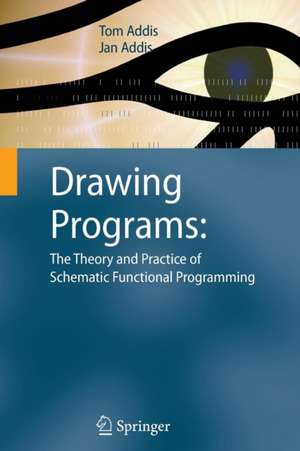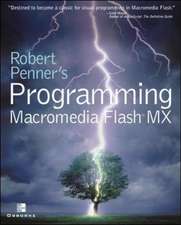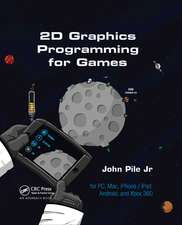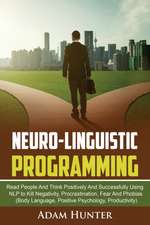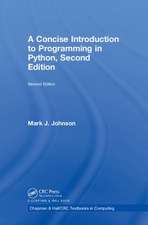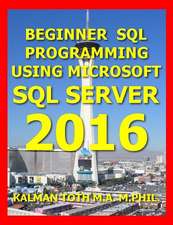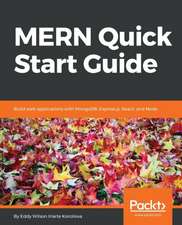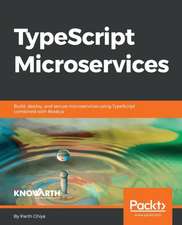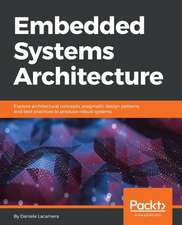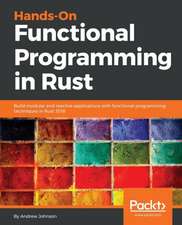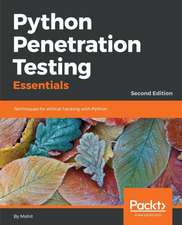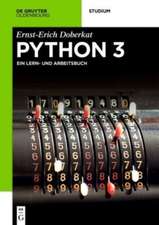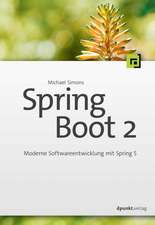Drawing Programs: The Theory and Practice of Schematic Functional Programming
Autor Tom Addis, Jan Addisen Limba Engleză Paperback – 4 feb 2010
Preț: 338.35 lei
Preț vechi: 422.94 lei
-20% Nou
Puncte Express: 508
Preț estimativ în valută:
64.74€ • 67.60$ • 53.58£
64.74€ • 67.60$ • 53.58£
Carte tipărită la comandă
Livrare economică 05-19 aprilie
Preluare comenzi: 021 569.72.76
Specificații
ISBN-13: 9781848826175
ISBN-10: 1848826176
Pagini: 416
Ilustrații: XVI, 395 p.
Dimensiuni: 155 x 235 x 34 mm
Greutate: 0.58 kg
Ediția:2010
Editura: SPRINGER LONDON
Colecția Springer
Locul publicării:London, United Kingdom
ISBN-10: 1848826176
Pagini: 416
Ilustrații: XVI, 395 p.
Dimensiuni: 155 x 235 x 34 mm
Greutate: 0.58 kg
Ediția:2010
Editura: SPRINGER LONDON
Colecția Springer
Locul publicării:London, United Kingdom
Public țintă
GraduateCuprins
Preface.- Why Schematic Functional Programming.- Making Changes.- In Pursuit of Elegance.- Mind Maps and Mechanisms.- Functional Thinking.- Thinking Practically.- Side-Effect Programming and Schematic Design.- Adult Things.- Higher Order Programming and Lower Level Activity.- Programming with Uncertainty: Theories, Models, and Programs.- Appendix I, II and III.- Index.
Recenzii
From the reviews:
“In Drawing Programs, Tom Addis (Univ. of Portsmouth, UK) and Jan Addis (Clarity Support, UK) teach readers how to program a computer using a special language they have developed called Clarity. … Drawing Programs is both a work on programming and a manual for the language. … The numerous illustrations are helpful. Summing Up: Recommended. Researchers and faculty.” (S. L. Tanimoto, Choice, Vol. 47 (11), July, 2010)
“The book presents the notion of schematic functional programming and demonstrates not only the concept but also how schematic functional programs can be processed … . A reader … can go through the book quite easily and try to use the constructs and typical patterns of schematic programming, and, in such a way, learn how to use schematic programming and become familiar with it. … a skilled programmer using several programming paradigms can get through the notion of the book in a short time.” (Dušan Kolář, Journal of Functional Programming, Vol. 22 (2), 2012)
“In Drawing Programs, Tom Addis (Univ. of Portsmouth, UK) and Jan Addis (Clarity Support, UK) teach readers how to program a computer using a special language they have developed called Clarity. … Drawing Programs is both a work on programming and a manual for the language. … The numerous illustrations are helpful. Summing Up: Recommended. Researchers and faculty.” (S. L. Tanimoto, Choice, Vol. 47 (11), July, 2010)
“The book presents the notion of schematic functional programming and demonstrates not only the concept but also how schematic functional programs can be processed … . A reader … can go through the book quite easily and try to use the constructs and typical patterns of schematic programming, and, in such a way, learn how to use schematic programming and become familiar with it. … a skilled programmer using several programming paradigms can get through the notion of the book in a short time.” (Dušan Kolář, Journal of Functional Programming, Vol. 22 (2), 2012)
Textul de pe ultima copertă
Drawing Programs: The Theory and Practice of Schematic Functional Programming describes a diagrammatic (schematic) approach to programming. It introduces a sophisticated tool for programmers who would rather work with diagrams than with text. The language is a complete functional language that has evolved into a representation scheme that is unique. The result is a simple coherent description of the process of modelling with the computer. The experience of using this tool is introduced gradually with examples, small projects and exercises. The new computational theory behind the tool is interspersed between these practical descriptions so that the reasons for the activity can be understood and the activity, in turn, illustrates some elements of the theory.
Access to the tool, its source code and a set of examples that range from the simple to the complex is free (see www.springer.com/978-1-84882-617-5). A description of the tool’s construction and how it may be extended is also given.
The authors’ experience with undergraduates and graduates who have the understanding and skill of a functional language learnt through using schema have also shown an enhanced ability to program in other computer languages. Readers are provided with a set of concepts that will ensure a good robust program design and, what is more important, a path to error free programming.
Access to the tool, its source code and a set of examples that range from the simple to the complex is free (see www.springer.com/978-1-84882-617-5). A description of the tool’s construction and how it may be extended is also given.
The authors’ experience with undergraduates and graduates who have the understanding and skill of a functional language learnt through using schema have also shown an enhanced ability to program in other computer languages. Readers are provided with a set of concepts that will ensure a good robust program design and, what is more important, a path to error free programming.
Caracteristici
Schematic functional programming uses diagrams, this book is the first to demonstrate a professional programming language based on a combination of both schema and functions Describes a schematic functional program development environment that has been built to provide all the tools, support and mechanisms a systems or program designer needs to make functional programs creatively Provides free access to ClarityPro software and the interpreter ClarityLite
